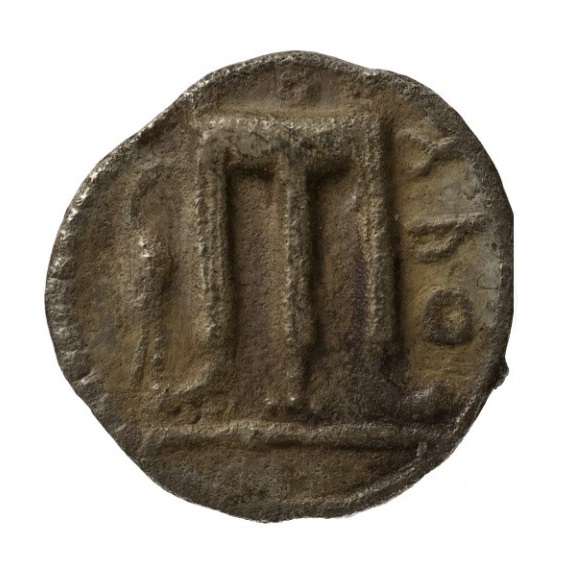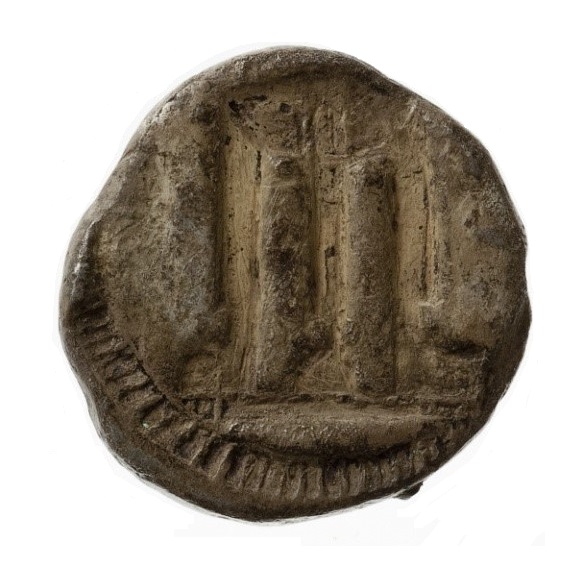Title: Stater of Kroton - 1988.03
Acquisition number: 1988.03
Author or editor: Douglas Kelly
Culture or period: Classical Greece.
Date: c. 480-430 BC.
Material: Metal - Silver
Object type: Coins - Greek
Dimensions: 21mm (w)
Origin region or location: Italy
Origin city: Kroton.
Display case or on loan: 5
Keywords: Coin, Greek, stater, Sicily, Magna Graecia, Myskellos, Phoenician alphabet
K.N. Rutter (ed.), Historia numorum: Italy (London, The British Museum, 2001), 6.
D.R. Sear, Greek Coins and their Values, vol. 1, Europe (London, Seaby, 1978), 256.
Classical Numismatic Group Auction, 928828.
Sylloge Nummorum Graecorum, USA, The Collection of the American Numismatic Society (New York, The American Numismatic Society, 1969-), 306-7.
1988.03
Stater of Kroton
Silver 6.75 g. 21 mm. c. 480-430 BC
Obv.: Delphic tripod, between stork r. and the Greek letter forms, top to bottom, koppa, mirror rho, omicron.
Rev.: Delphic tripod in incuse.
Like the stater of Metapontion (1973.25), this stater from Kroton in southern Italy (modern Crotone on the instep of Italy) was struck with the technique whereby the obverse type in relief is reproduced exactly in incuse on the reverse.
Kroton, the largest Greek city and the biggest producer of coinage in Italy, began issuing staters c. 530 BC. This dating was established by a notable Australian contribution to numismatics: P.J. Bicknell, ‘An Early Incuse Stater of Kroton Overstruck on a Pegasus’, Antichthon 3 (1969), 1-4, with Plate. These staters fall into three phases, the present coin belonging to the second, from c. 510-450 BC. As with Metapontine staters, Krotoniate staters became thicker with a reduced diameter over time, this one belonging to the ‘medium’ phase between the early ‘spread’ staters and the late ‘dumpy’ ones. Kroton’s issuing of staters of this type, and, curiously, no other silver coinage bearing the city’s insignia, continued until late in the fifth century BC.
The tripod alludes to Kroton’s foundation legend that Myskellos was ordered to found the colony when he consulted the Delphic oracle about having children.
The letters on the obverse are the abbreviation of the city’s name, written in mirror image characters and reading right to left, with an initial Q-like koppa (from the Phoenician alphabet). We see this character also on the Corinthian stater (1967.15). Right to left inscriptions, sometimes with mirror image characters, are sometimes found on coins of the Greek colonies in southern Italy in the archaic period (eighth to sixth centuries BC). Later, in the fifth and fourth centuries BC, the standardised Ionic alphabet is used.
K.N. Rutter (ed.), Historia numorum: Italy (London, The British Museum, 2001), 6.
D.R. Sear, Greek Coins and their Values, vol. 1, Europe (London, Seaby, 1978), 256.
Classical Numismatic Group Auction, 928828.
Sylloge Nummorum Graecorum, USA, The Collection of the American Numismatic Society (New York, The American Numismatic Society, 1969-), 306-7.

